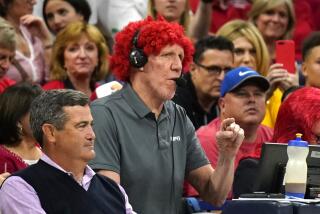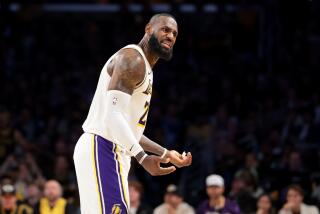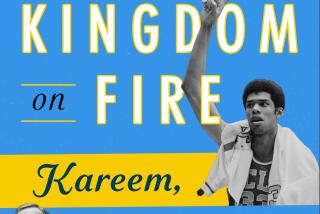On Road, Old Bullets Were All-Time Duds
- Share via
They played their home games in an old roller-skating rink, on a floor of unvarnished wood. They changed their team colors three times during the 1953-54 National Basketball Association season. They were a quarrelsome lot, their locker room split into factions. Their coach allegedly drank. Sometimes, particularly on the road, he didn’t even show up for games.
They were the Baltimore Bullets and they folded on Thanksgiving in 1954, but not before setting a league record by losing 32 straight games in opponents’ gyms, a streak encompassing part of one season and all of another. They are back in the news these days because the New Jersey Nets have lost 31 in a row on the road, threatening the record, one of the NBA’s oldest.
“But we had a whole different set of problems than the Nets do now,” Paul Hoffman was saying at his house in Glenarm, Md. An All-American at Purdue in the 1940s, he was one of the Bullets’ best players in those years, and the only one who still lives in the area. Now 64, he works as a therapist at the Maryland Rehabilitation Center.
He paints an unseemly portrait of his Bullets. The NBA was still a fledgling operation then, low-paying and largely ignored, and the Bullets were particularly flimsy. Their coach and general manager was Clair Bee, one of the game’s legends, a Hall of Famer who coached championship teams at Long Island University. He was out of his element in the NBA, though, and near the end of his career.
“Clair was anything but stable,” Hoffman said. “He was drinking heavily. It’s sad. He’s a legend, but to us he was anything but a coach. I’ve never really said anything about it publicly. But he didn’t coach, didn’t manage, wasn’t around the club at all. We were on our own, and we just got our butts beat.”
They were not completely without talent. Their best player, a big man named Ray Felix, scored almost 7,000 points in his pro career. Hoffman was among the league leaders in assists. Bob Houbregs, a forward, had been an All-American at Washington. The Bullets won almost 40 percent of their home games during the two seasons in which they built the losing streak.
They still were the worst team in the league, though, and it started at the top. Instead of paying for a training camp before the 1954-55 season, Bee took the team to Japan on a USO-sponsored trip. He was often absent without explanation, and the team came back unprepared for the season. It was just as hard in those days to win on the road. The disorganized Bullets were an easy mark.
“Clair’s secretary would call me before a trip to tell me he would meet us on the road,” Hoffman said. “I’d go by the office and get the plane tickets, and I’d take the club on the road. We’d go for three or four games, and maybe for the first three he wouldn’t show up. I coached the team. We’d just get waxed.
“We didn’t have any cohesion at all. Bee had brought in three of his players from LIU. Al Roges, Rollie Hans and Hal Uplinger. They didn’t have any damn business being in the league. They caused problems on the floor and off. If they wanted something, or if there was a dispute, they’d go to Clair and he’d listen to them. We had a lot of dissension.”
Meanwhile, the road losses mounted. (The streak did not include games played at neutral sites, of which there were many in those days.) The Bullets’ last road victory came on Jan. 1, 1953, an 83-81 defeat of the Milwaukee Hawks, in overtime. They lost the rest of their road games that season, and every one in the 1953-54 season.
“Toward the end of that year, we lost two in one night in Milwaukee,” Hoffman said. “They’d gotten fogged out trying to come here for a game, and Clair said we’d just make it up the next time we went out there. Played a doubleheader. Lost both by almost the same damn score (65-54 and 64-54). We were tired. You try playing a doubleheader.”
By that point in the season, Bee had changed the team’s uniforms three times. “We’d always used navy blue and mustard yellow on the road,” Hoffman said, “but Bee didn’t like that, so he went and bought us solid black road uniforms. But we lost so much he said, ‘Shoot, you look worse in black than yellow and blue,’ and went and bought cardinal red.”
Regardless of the color they wore, the Bullets would go into Minneapolis and lose to the Lakers and George Mikan, the NBA’s elite in those days. They would lose in Boston to Bob Cousy, Bill Sharman and the Celtics; in Syracuse to Dolph Schayes and the Nationals; in Philadelphia to Neil Johnston and the Warriors.
The eight-team NBA was just beginning to gain fans and compete with the popular college game, and teams were beginning to think about moving into larger arenas. The Bullets had no chance. They played their home games at the Baltimore Coliseum, a little building with 3,900 seats in it. Tickets cost $2, and crowds were skimpy.
“They’d have roller skating one night and we’d play the next,” Hoffman said. “The floor was just raw wood, no shellac on it. No one came to see us. We always looked like we were getting ready to disband.”
They finally did after playing 14 games in the 1954-55 season. They lost their first two road games that year, stretching their streak to 34 in a row, then broke it by beating the Knicks in New York. But all their games that season were wiped from the books when the team disbanded. The players learned they were folding after a 92-89 loss in Fort Wayne, Ind., to the Pistons.
“We didn’t have enough money to get back to Baltimore,” Hoffman said. “We’d run out of meal money, expense money, didn’t even have enough to pay for the hotel. The hotel manager called and said, ‘Don’t leave until you pay.’ I called the airport and told them to hold the plane, and we hired a limo that came around to the back of the hotel. We slid the bags out, jumped in and took off.
“The plane was waiting for us when we got to the airport. We went through a side gate of the terminal, took the baggage right onto the plane, and they closed the door and took off. We made it back and I never paid for the limo or the hotel.”
The Bullets’ best players were picked up by other teams. One from the 1953-54 season, James Luisi, got into acting and years later wound up playing James Garner’s lieutenant on “The Rockford Files.” Another, Hal Uplinger, got into television production and helped pioneer the use of instant replay.
Hoffman retired after the season -- “there was no money in it” -- and went back to Purdue, where he replaced a fraternity brother named Hank Stram as the baseball coach and assistant basketball coach. He came back to Baltimore and was the Bullets’ general manager when they returned in 1963.
He never again ran into Clair Bee. The life of the famous coach, who invented the 1-3-1 defense and later wrote a series of children’s sports books, was at a low ebb during his years in Baltimore.
“I stayed away from him after that,” Hoffman said. “I wasn’t very happy with the way things turned out. It hurt my pro career. We just weren’t a very good team. We lost a lot of games. But we never had much of a chance.”
More to Read
Go beyond the scoreboard
Get the latest on L.A.'s teams in the daily Sports Report newsletter.
You may occasionally receive promotional content from the Los Angeles Times.










